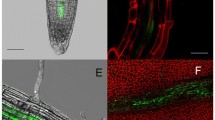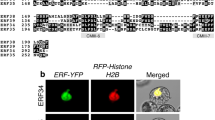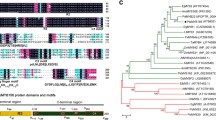Abstract
DUF579 (domain of unknown function 579) family proteins contain a DUF579 domain structure but vary greatly in their overall sequence similarity. Several DUF579 proteins have been found to play a role in cell wall biosynthesis in Arabidopsis, while DUF579 family genes have not yet been systematically investigated in Populus. In this study, the Populus DUF579 family proteins were found to be localized in different cell types and subcellular locations. The diverse expression patterns of the proteins indicate that they may perform different functions in Populus. Among the DUF579 family members, PtrDUF579-1 is found to be specifically expressed in vascular cambium zone cells where it is localized in the Golgi apparatus. Suppression of PtrDUF579-1 expression reduced plant height and stem diameter size. Cambium cell division and xylem tissue growth was inhibited while secondary cell wall formation was unchanged in PtrDUF579-1 suppressed plants. Cell walls analysis showed that the composition of the pectin fraction of the cambium cell wall was altered while other polysaccharides were not affected in PtrDUF579-1 suppressed plants. This observation suggest cambium expressed PtrDUF579-1 may affect cell wall biosynthesis and be involved in cambium cell proliferation in Populus. Overall, DUF579 family proteins play a diverse set of roles in Populus.







Similar content being viewed by others
References
An J, O’Neill MA, Albersheim P, Darvill AG (1994) Isolation and structural characterization of β-d-glucosyluronic acid and 4-O-methyl β-D-glucosyluronic acid-containing oligosaccharides from the cell-wall pectic polysaccharide, rhamnogalacturonan I. Carbohydr Res 252:235–243
Atmodjo MA, Hao Z, Mohnen D (2013) Evolving views of pectin synthesis. Annu Rev Plant Biol 64(1):747–779
Bouton S, Leboeuf E, Mouille G, Leydecker MT, Talbotec J, Granier F, Lahaye M, Hofte H, Truong HN (2002) QUASIMODO1 encodes a putative membrane-bound glycosyltransferase required for normal pectin synthesis and cell adhesion in Arabidopsis. Plant Cell 14(10):2577–2590
Brown D, Wightman R, Zhang Z, Gomez LD, Atanassov I, Bukowski JP, Tryfona T, McQueen-Mason SJ, Dupree P, Turner S (2011) Arabidopsis genes IRREGULAR XYLEM (IRX15) and IRX15L encode DUF579-containing proteins that are essential for normal xylan deposition in the secondary cell wall. Plant J 66(3):401–413
Caffall KH, Mohnen D (2009) The structure, function, and biosynthesis of plant cell wall pectic polysaccharides. Carbohydr Res 344(14):1879–1900
Cankar K, Kortstee A, Toonen MA, Wolters-Arts M, Houbein R, Mariani C, Ulvskov P, Jorgensen B, Schols HA, Visser RG (2014) Pectic arabinan side chains are essential for pollen cell wall integrity during pollen development. Plant Biotechnol J 12:492–502
Chang S, Puryear J, Cairney J (1993) A simple and efficient method for isolating RNA from pine trees. Plant Mol Biol Rep 11(2):113–116
Foster CE, Martin TM, Pauly M (2010) Comprehensive compositional analysis of plant cell walls (lignocellulosic biomass) part II: carbohydrates. JoVE 37
Gaspar Y, Johnson KL, McKenna JA, Bacic A, Schultz CJ (2001) The complex structures of arabinogalactan-proteins and the journey towards understanding function. Plant Cell Walls. Springer, Berlin, pp 161–176
Harholt J, Suttangkakul A, Vibe Scheller H (2010) Biosynthesis of pectin. Plant Physiol 153(2):384–395
Iwai H, Masaoka N, Ishii T, Satoh S (2002) A pectin glucuronyltransferase gene is essential for intercellular attachment in the plant meristem. Proc Natl Acad Sci USA 99(25):16319–16324
Jensen JK, Kim H, Cocuron JC, Orler R, Ralph J, Wilkerson CG (2011) The DUF579 domain containing proteins IRX15 and IRX15-L affect xylan synthesis in Arabidopsis. Plant J 66(3):387–400
Kalluri UC, Hurst GB, Lankford PK, Ranjan P, Pelletier DA (2009) Shotgun proteome profile of Populus developing xylem. Proteomics 9(21):4871–4880
Lee C, Teng Q, Zhong R, Yuan Y, Haghighat M, Ye ZH (2012) Three Arabidopsis DUF579 domain-containing GXM proteins are methyltransferases catalyzing 4-O-methylation of glucuronic acid on xylan. Plant Cell Physiol 53(11):1934–1949
Li L, Zhou Y, Cheng X, Sun J, Marita JM, Ralph J, Chiang VL (2003) Combinatorial modification of multiple lignin traits in trees through multigene cotransformation. Proc Natl Acad Sci USA 100(8):4939–4944
Li M, Xiong G, Li R, Cui J, Tang D, Zhang B, Pauly M, Cheng Z, Zhou Y (2009) Rice cellulose synthase-like D4 is essential for normal cell-wall biosynthesis and plant growth. Plant J 60(6):1055–1069
Lluveras-Tenorio A, Mazurek J, Restivo A, Colombini MP, Bonaduce I (2012) Analysis of plant gums and saccharide materials in paint samples: comparison of GC–MS analytical procedures and databases. Chem Cent J 6(1):1–16
Mohnen D (2008) Pectin structure and biosynthesis. Curr Opin Plant Biol 11(3):266–277
Nelson BK, Cai X, Nebenfuhr A (2007) A multicolored set of in vivo organelle markers for co-localization studies in Arabidopsis and other plants. Plant J 51(6):1126–1136
O’Neill MA, Eberhard S, Albersheim P, Darvill AG (2001) Requirement of borate cross-linking of cell wall rhamnogalacturonan II for Arabidopsis growth. Science 294(5543):846
Song D, Shen J, Li L (2010) Characterization of cellulose synthase complexes in Populus xylem differentiation. New Phytol 187:777–790
Song D, Xi W, Shen J, Bi T, Li L (2011) Characterization of the plasma membrane proteins and receptor-like kinases associated with secondary vascular differentiation in poplar. Plant Mol Biol 76(1–2):97–115
Staehelin LA, Moore I (1995) The plant Golgi apparatus: structure, functional organization and trafficking mechanisms. Annu Rev Plant Biol 46(1):261–288
Tamura K, Peterson D, Peterson N, Stecher G, Nei M, Kumar S (2011) MEGA5: molecular evolutionary genetics analysis using maximum likelihood, evolutionary distance, and maximum parsimony methods. Mol Biol Evol 28(10):2731–2739
Thakur BR, Singh RK, Handa AK, Rao M (1997) Chemistry and uses of pectin—a review. Crit Rev Food Sci 37(1):47–73
Tryfona T, Liang H-C, Kotake T, Tsumuraya Y, Stephens E, Dupree P (2012) Structural characterization of Arabidopsis leaf arabinogalactan polysaccharides. Plant Physiol 160(2):653–666
Tuskan GA, Difazio S, Jansson S, Bohlmann J, Grigoriev I, Hellsten U, Putnam N, Ralph S, Rombauts S, Salamov A (2006) The genome of black cottonwood, Populus trichocarpa (Torr. & Gray). Science 313(5793):1596–1604
Urbanowicz BR, Peña MJ, Ratnaparkhe S, Avci U, Backe J, Steet HF, Foston M, Li H, O’Neill MA, Ragauskas AJ (2012) 4-O-methylation of glucuronic acid in Arabidopsis glucuronoxylan is catalyzed by a domain of unknown function family 579 protein. Proc Natl Acad Sci USA 109(35):14253–14258
Yuan Y, Teng Q, Zhong R, Ye Z-H (2014) Identification and biochemical characterization of four wood-associated glucuronoxylan methyltransferases in Populus. PLoS One 9(2):e87370
Acknowledgments
We thank Xiaoshu Gao (Shanghai Institute of Plant Physiology and Ecology, SIPPE) for observations with LCSM, and Wenli Hu for assistance with the GC–MS analysis (SIPPE). This work was supported by the National Key Basic Research Program of China (2012CB114502), the National Natural Science Foundation of China (31130012) to LL, Shanghai Institutes for Biological Sciences (2012KIP302) to DS.
Conflict of interest
No conflict of interest declared.
Author information
Authors and Affiliations
Corresponding author
Electronic supplementary material
Below is the link to the electronic supplementary material.
11103_2014_206_MOESM1_ESM.tif
Fig. S1. Protein structure of three PtrDUF579 proteins and their Arabidopsis homologs. The predicted transmembrane domains were underlined. The specific peptides selected for antibody production were framed by rectangle. (TIFF 1300 kb)
11103_2014_206_MOESM2_ESM.tif
Fig. S2. Detection of PtrDUF579-1, PtrDUF579-3 and PtrDUF579-9 in plant tissues. The proteins were isolated from developing xylem and phloem tissues and analyzed by Western blot. The PtrDUF579 antibodies were verified for their specificity. DX: developing xylem; DP: developing phloem. (TIFF 170 kb)
11103_2014_206_MOESM3_ESM.tif
Fig. S3. Localization of the PtrDUF579-1 protein in procambium. PtrDUF579-1 is localized in procambium cells indicated by arrow. Bar: 500 μm. (TIFF 1070 kb)
11103_2014_206_MOESM4_ESM.tif
Fig. S4. Internode growth of PtrDUF579-1 suppressed plants. (A) PtrDUF579-1 suppressed plants with six month old. Bar: 20 cm. (B) Internode length was decreased in PtrDUF579-1 suppressed plants. In: internode. Bar: 5 cm. (C) The 10th Internode length of PtrDUF579-1 suppressed plants. Each transgenic line was multiplied through cutting propagation for analysis of biological repeats. Significance was determined by Student’s t test : **, P < 0.01. The values are mean ± SE, n = 5. (TIFF 640 kb)
Rights and permissions
About this article
Cite this article
Song, D., Sun, J. & Li, L. Diverse roles of PtrDUF579 proteins in Populus and PtrDUF579-1 function in vascular cambium proliferation during secondary growth. Plant Mol Biol 85, 601–612 (2014). https://doi.org/10.1007/s11103-014-0206-9
Received:
Accepted:
Published:
Issue Date:
DOI: https://doi.org/10.1007/s11103-014-0206-9




